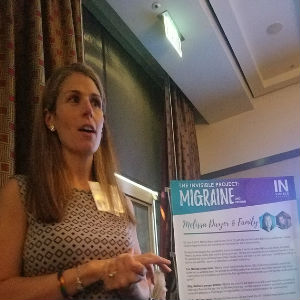 Nicole Hemmenway was appointed Interim CEO of U.S. Pain earlier this spring. Below, she answers some insight into her pain journey and her vision for the organization going forward.
Nicole Hemmenway was appointed Interim CEO of U.S. Pain earlier this spring. Below, she answers some insight into her pain journey and her vision for the organization going forward.
1) When were you diagnosed with chronic pain?
I’ve lived with chronic pain for most of my life. In 1994, at the age of 13, I sprained my ankle playing basketball–but the pain refused to go away. I was eventually given given the diagnosis of reflex sympathetic dystrophy (known today as complex regional pain syndrome, or CRPS). After extensive physical therapy didn’t ease the pain or reduce my symptoms, my doctor decided to try an epidural nerve block. It worked–I was fortunate to go into remission for four years. But then, as a senior in high school, a high-five gone awry brought the condition back in full swing.
2) What do you think is the hardest part of having chronic pain?
That’s a difficult question to answer, but I believe one of the hardest things is the invisibility of pain. It’s difficult for people–whether family members or doctors–to believe in and understand something they can’t see. That results in a lack of compassion, validation, and support. At U.S. Pain, we try to shed light on the hidden struggles of pain.
3) What do you attribute to achieving and maintaining remission of CRPS?
After years of failed treatments and doctors refusing to truly listen to what I believed to be best for me, I found a doctor who created a noninvasive, electro-stimulation unit that was key in helping me gain relief. I also believe the lifestyle changes I made at the time have helped me maintain those improvements including: diet and nutrition, exercise, complementary therapies (especially acupuncture), and always ensuring I take time for self-care.
4) How did you first get involved with U.S. Pain?
After writing my memoir in 2010, I was invited to attend an event for a different patient organization. The connections I made there eventually led to me joining up with U.S. Pain Foundation. I believe so wholeheartedly in our mission, in people helping people, and programs that support patients. I felt connected to U.S. Pain because it was made up of individuals going through the same thing I did, and I loved knowing that because of them, others wouldn’t have to go through their pain journey alone. (I wished that U.S. Pain had been around when I was first diagnosed!).
5) What is your favorite tip for other pain warriors?
Be an empowered patient: ask questions, engage in your pain management plan, be sure that you don’t settle, and above all, trust your gut. No one knows your body like you do, and no one else but you can truly advocate for your needs. And most important, remember that you are stronger and more capable than you realize. Don’t give up hope!
6) What is one thing most people don’t know about you?
As a mother of three fun-loving, amazing boys, I know a lot about pain management and advocacy, but I also know a ton about superheroes and dinosaurs.
Hemmenway encourages pain warriors to reach out to her with ideas and feedback at nicole@uspainfoundation.org.
